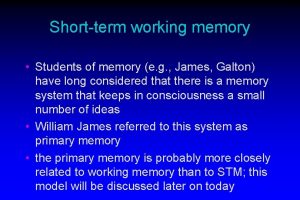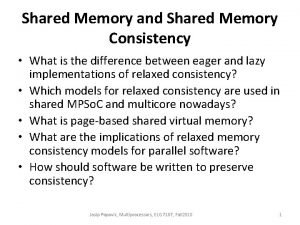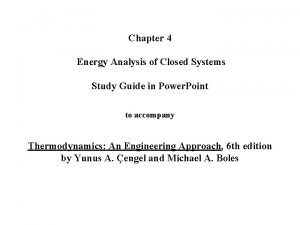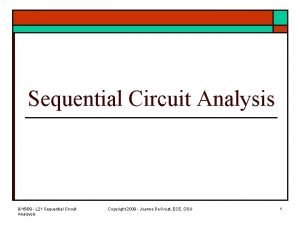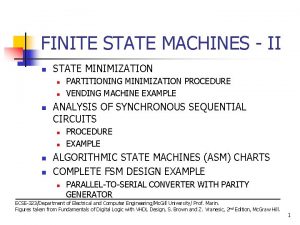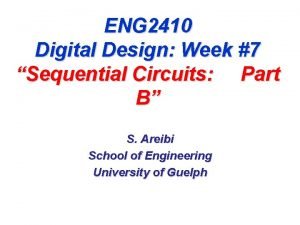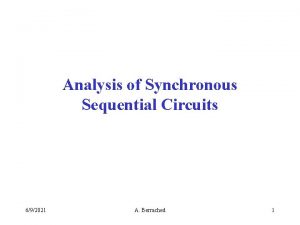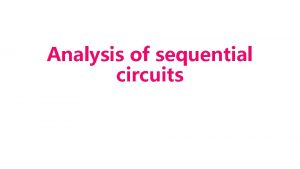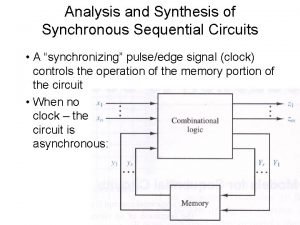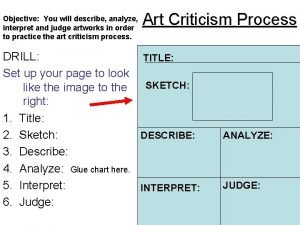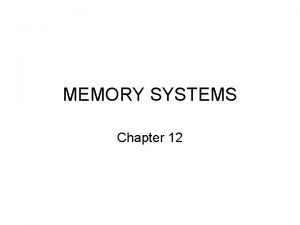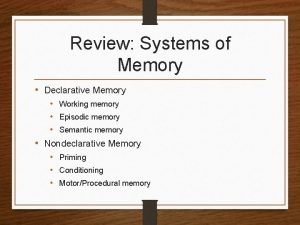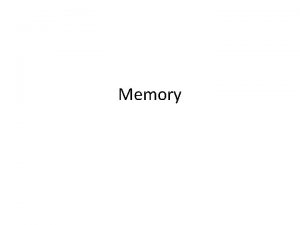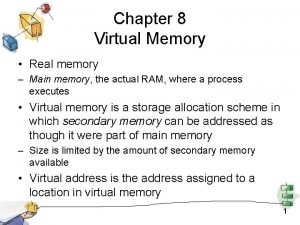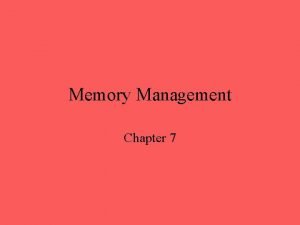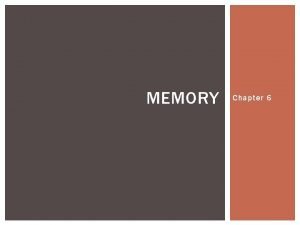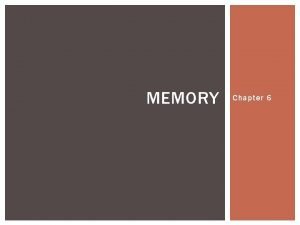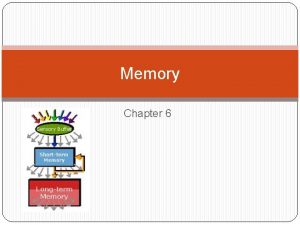Chapter 6 Analysis of Sequential Systems Sequential Memory



































- Slides: 35

Chapter 6 Analysis of Sequential Systems Sequential Memory Feedback

Engineering Takes three approaches 1. Analysis – looks at a system to determine how it works 2. Design – looks at how to make a system 3. Application – looks at integration of existing designs for solution Chapter 6 is analysis Chapter 7 is design Combinational logic uses AND, OR, NOT to create circuit. Sequential logic uses Flip / Flops to create memory. Usually adds combinational as input and output to the memory.

Asynchronous - USB Synchronous – Cell phone “ON” duration can vary Pulse is often choice Power depends on “ON” duration Time Clock Enable Simply another input Frequency = 1/T 200 MHz = 50 microsec Leading edge – active high Trailing or falling edge – active low Signal is active as approaches active level Transition not sharp, but has slope


CE 6. A system with one input x and one output z such that z = 1 iff x has been 1 for at least three consecutive clock times. State: what is stored in memory. It is stored in binary devices, but the information to be stored is not always naturally binary. Timing trace: a set of values for the input and output (and sometimes the state or other variables of the system, as well) at consecutive clock times.

State table: shows for each input combination and each state, what the output is and what the next state is, that is, what is to be stored in memory after the next clock. State diagram (or state graph): a graphical representation of the state table. Moore machine output occurs at next state Requires one more state (FF) but less logic

Mealy machine output occurs at present state + input Requires one less state (FF) but more logic

Flip Flops / Latch S = Set R = Reset When S=0, R=1, Qt+1 = 0 When S=1, R=0, Qt+1 = 1

Asynchronous (RS F/F) Characteristic Table Excitation Table Characteristic Eq. Symbol Circuit

Characteristic Table Excitation Table Characteristic Eq. Synchronous Symbol Circuit


Flip flop is a latch triggered by a clock 1. Has feedback 2. Is memory device 3. Holds the state Q’ S = set, output q=1 R = reset, output q=0 Q = (R + P)´ Q’ = (S + Q)´

F/F designs SR is the basic device Q indeterminant w/ SR=11 JK uses feedback to fix D is delay D into S & D’ into R T is toggle T into both J & K Q’











D 1 = q 1 q´ 2 + x q´ 1 D 2 = xq 1 z = q´ 2

D 1 = q 1 q´ 2 + x q´ 1 D 2 = xq 1 z = q´ 2 PS q 1 q 2 00 01 10 11 x=0 D 1 D 2 0 0 1 0 x=1 D 1 D 2 1 1 1 0 x=0 q 1*q 2* 0 0 1 0 x=1 q 1*q 2* 1 1 1 0 z 1 1 0 0

D 1 = q 1 q´ 2 + x q´ 1 D 2 = xq 1 z = q´ 2 PS q 1 q 2 00 01 10 11 x=0 D 1 D 2 00 00 10 00 x=1 D 1 D 2 10 10 11 01 x=0 q 1*q 2* 00 00 10 00 x=1 q 1*q 2* 10 10 11 01 z 1 1 0 0 Moore: Output depends Only on state, So show out inside state

J 1 = x K 1 = x. B´ J 2 = K 2 = x + A´ z=A+B Moore machine, output z does not depend on input x

J 1 = x K 1 = x. B´ J 2 = K 2 = x + A´ z=A+B PS AB 00 01 10 11 1. 2. 3. 4. 5. 6. 7. 8. x=0 J 1 K 1 00 00 x=1 J 2 K 2 11 11 00 00 J 1 K 1 Row 1, look at both A(1) B(2) Start w/ x=0 PS, A=0 B=0 (Qa=0 Qb=0) J 1=K 1=0 J 2=K 2=1 Then from table get NS J 1=0, K 1=0→ A*=A=0 J 2=1, K 2=1 →B*=B’=1 J 2 K 2 x=0 A*B* 01 00 1. 2. 3. 4. 5. 6. 7. 8. x=1 A*B* z 0 1 1 1 Row 2 Start w/ x=0 PS, A=0 B=1 (Qa=0 Qb=1) J 1=K 1=0 J 2=K 2=1 Then from table get NS J 1=0, K 1=0→ A*=A=0 J 2=1, K 2=1 →B*=B’=0

J 1 = x K 1 = x. B´ J 2 = K 2 = x + A´ z=A+B PS AB 00 01 10 11 1. 2. 3. 4. 5. x=0 J 1 K 1 00 00 x=1 J 2 K 2 11 11 00 00 J 1 K 1 11 10 x=0, look at A (1) only J 1=K 1=0 J 2=K 2=1 Then from table get NS J 1=0, K 1=0→ A*=A J 2 K 2 11 11 x=0 A*B* 0 0 1 1 1. 2. 3. 4. 5. 6. x=1 A*B* 1 1 0 1 z 0 1 1 1 x=1, look at A (1) only J 1=1, K 1=B’ When B=0, J 1=K 1 A=Toggle When B=1, J 1=1, Ka=0 A=1

J 1 = x K 1 = x. B´ J 2 = K 2 = x + A´ z=A+B PS AB 00 01 10 11 x=0 J 1 K 1 00 00 x=1 J 2 K 2 11 11 00 00 1. 2. 3. 4. 5. 6. 7. J 1 K 1 11 10 J 2 K 2 11 11 x=0 A*B* 01 00 10 11 look at B (2) only When A=0, J 2=K 2=1 B*=toggle When A=1, J 2=K 2=x for x=0, B*=B for x=1, B*=toggle J 1=0, K 1=0→ A*=A x=1 A*B* 11 10 01 11 z 0 1 1 1

J 1 = x K 1 = x. B´ J 2 = K 2 = x + A´ z=A+B PS AB 00 01 10 11 x=0 J 1 K 1 00 00 x=1 J 2 K 2 11 11 00 00 J 1 K 1 11 10 J 2 K 2 11 11 x=0 A*B* 01 00 10 11 x=1 A*B* 11 10 01 11 z 0 1 1 1

J 1 = x K 1 = x. B´ J 2 = K 2 = x + A´ z=A+B Alternative is use Boolean equations For J-K f/f q*=Jq’ + K’q For this problem A* = Ja. A’ + Ka’A = x. A’ + (x. B’)A = x. A” + x’A + AB B* = Jb’ + Kb’B = (x + A’)B’ + (x + A’)B = x. B’ + A’B’ + x’AB PS AB 00 01 10 11 x=0 J 1 K 1 00 00 x=1 J 2 K 2 11 11 00 00 J 1 K 1 11 10 J 2 K 2 11 11 x=0 A*B* 01 00 10 11 x=1 A*B* 11 10 01 11 z 0 1 1 1

D 1 = xq 1 + xq 2 D 2 = xq´ 1 q´ 2 z = xq 1 Mealy, output z depends on input x, as well as state variables (F/F) So state table will have output for x=0 & for x=1 D f/f, q* = D q 1* = xq 1 + xq 2 q 2* = xq´ 1 q´ 2

D 1 = xq 1 + xq 2 D 2 = xq´ 1 q´ 2 z = xq 1 PS q 1 q 2 00 01 10 11 x=0 D 1 D 2 00 00 x=1 D 1 D 2 01 10 10 10 x=1 x=0 x=1 q 1*q 2* z 00 01 0 0 00 10 0 1 State 11 is never reached Mealy: Output depends on state & input, So show out on transition

D 1 = xq 1 + xq 2 PS q 1 q 2 00 01 10 11 x=0 D 1 D 2 00 00 x=1 D 1 D 2 01 10 10 10 x=1 x=0 x=1 q 1*q 2* z 00 01 0 0 00 10 0 1 D 2 = xq´ 1 q´ 2 z = xq 1 Glitch z = x q 1 x=1 after q 1=1 Fixed by next clock
 Semantic knowledge
Semantic knowledge Implicit explicit memory
Implicit explicit memory Long term memory vs short term memory
Long term memory vs short term memory Internal memory and external memory
Internal memory and external memory Primary memory and secondary memory
Primary memory and secondary memory Logical memory is broken into
Logical memory is broken into Which memory is the actual working memory?
Which memory is the actual working memory? Page fault
Page fault Virtual memory in memory hierarchy consists of
Virtual memory in memory hierarchy consists of Eidetic memory vs iconic memory
Eidetic memory vs iconic memory Shared vs distributed memory
Shared vs distributed memory Slave systems working memory model
Slave systems working memory model Nimble page management for tiered memory systems
Nimble page management for tiered memory systems Memory consistency
Memory consistency Energy analysis of closed systems
Energy analysis of closed systems Sequential circuit analysis
Sequential circuit analysis Rangkaian sekuensial adalah
Rangkaian sekuensial adalah Finite
Finite Analysis of sequential circuits
Analysis of sequential circuits Analysis of synchronous sequential circuits
Analysis of synchronous sequential circuits Analysis of sequential circuit
Analysis of sequential circuit Sequential circuit analysis
Sequential circuit analysis State diagram
State diagram Describe analyze interpret evaluate
Describe analyze interpret evaluate Decision support systems and intelligent systems
Decision support systems and intelligent systems Dicapine
Dicapine Embedded systems vs cyber physical systems
Embedded systems vs cyber physical systems Engineering elegant systems: theory of systems engineering
Engineering elegant systems: theory of systems engineering Chapter 10 memory and thought answers
Chapter 10 memory and thought answers Chunking psychology definition
Chunking psychology definition Loftus experiment
Loftus experiment Systems analysis & design in an age of options pdf
Systems analysis & design in an age of options pdf Gantt chart system analysis and design
Gantt chart system analysis and design Systems analysis and design in a changing world
Systems analysis and design in a changing world System analysis and design in a changing world
System analysis and design in a changing world Systems analysis and design dennis
Systems analysis and design dennis











